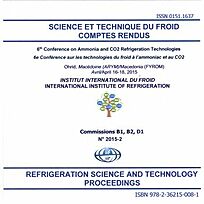
Résumé
The use of waste heat of distributed cogeneration plants for thermal driven refrigeration systems can improve the annual utilization ratio significantly. This results in so called trigeneration plants. The use of thermal energy at temperatures from a minimum of 65°C to 90°C or more is a typical application for systems using water and lithium bromide solution as working fluid. With this kind of sorption refrigeration systems it is possible to provide cooling at temperatures close to but not below 0°C. Here a newly designed resorption refrigeration system based on NH3/H2O is introduced. Compared to a conventional absorption cycle with a condenser and an evaporator this resorption system consists basically of two solution absorption cycles. The new designed refrigeration system with ammonia and water as the working fluid is able to provide cooling temperatures below 0°C by using waste heat at temperatures in the range of 65°C to 90°C. An attached ice storage system is able to retain the cooling capacity. Thus allows the temporarily decoupling of the cooling demand from the generated thermal capacity. The application of plate heat exchangers together with the low pressure level of the resorption process makes it possible to design compact and cost effective plants.
Documents disponibles
Format PDF
Pages : 8 p.
Disponible
Prix public
20 €
Prix membre*
15 €
* meilleur tarif applicable selon le type d'adhésion (voir le détail des avantages des adhésions individuelles et collectives)
Détails
- Titre original : Design of a novel resorption refrigeration system with an attached ice storage system.
- Identifiant de la fiche : 30014593
- Langues : Anglais
- Source : 6th Conference on Ammonia and CO2 Refrigeration Technology. Proceedings: Ohrid, North Macedonia, April 16-18, 2015.
- Date d'édition : 16/04/2015
Liens
Voir d'autres communications du même compte rendu (53)
Voir le compte rendu de la conférence
Indexation
-
Comparison of a new designed resorption refrige...
- Auteurs : GRUND M., HESSE U., WEIMER T., et al.
- Date : 16/08/2015
- Langues : Anglais
- Source : Proceedings of the 24th IIR International Congress of Refrigeration: Yokohama, Japan, August 16-22, 2015.
- Formats : PDF
Voir la fiche
-
Konstruktion und Betrieb eines kleinen Eisspeic...
- Auteurs : KOLLER T., ZETZSCHE M., MÜLLER-STEINHAGEN H.
- Date : 21/11/2007
- Langues : Allemand
- Source : DKV-Tagungsbericht 2007, Hannover.
Voir la fiche
-
Energy storage system by using lithium-bromide ...
- Auteurs : KAZUHIKO M.
- Date : 22/04/2003
- Langues : Anglais
- Source : Cryogenics and refrigeration. Proceedings of ICCR 2003.
Voir la fiche
-
Extended operational flexibility of trigenerati...
- Auteurs : HILLIGWEG A.
- Date : 09/05/2013
- Langues : Anglais
- Source : 5th Conference on Ammonia Refrigeration Technology. Proceedings: Ohrid, North Macedonia, May 9-11, 2013.
- Formats : PDF
Voir la fiche
-
A performance study on a chemical energy storag...
- Auteurs : WONGSUWAN W., RUNGPIBOONSOPIT T., CHATCHAWAN C., et al.
- Date : 01/08/2004
- Langues : Anglais
- Source : Natural Working Fluids 2004: 6th IIR-Gustav Lorentzen Conference
- Formats : PDF
Voir la fiche
